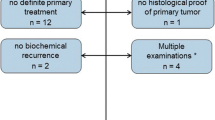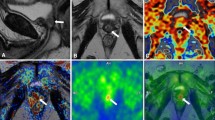Abstract
The objective of the systematic review and meta-analysis was to evaluate whether the choice between two radiotracers, 11C-choline (11C-cho) and 18F-fluorocholine (18F-FCH) for PET/CT, and different acquisition protocols contributed to detect metastases for patients with biochemical recurrence of prostate cancer after radical prostatectomy or radiotherapy. We searched in January 2016 in Pubmed and Embase for articles that had used radiolabeled choline PET/CT in restaging. The meta-analysis evaluated technical and clinical aspects. Across 18 articles 1 219 of 2 213 patients (54.9 %) had a positive radiolabeled PET/CT image. Mean of the mean/median restaging PSA levels was 3.6 ± 2.7 ng/mL (range 0.5–10.7 ng/mL). Six articles with 11C-cho PET/CT had a radiation activity of 561 ± 122 MBq and it was 293 ± 47 MBq in 12 articles with 18F-FCH PET/CT. The difference was significant (P = 0.007, t test). Uptake time was 5 min in articles with 11C-cho PET/CT and it was 29 ± 24 min in articles with 18F-FCH PET/CT. The difference was significant (P = 0.02, t test). Thereby the detection rates of metastatic sites in articles with 11C-cho (30 ± 5 %) and 18F-FCH (39 ± 5 %) did not differ significantly (P = 0.26, t test). In linear regression analyses of the articles, the radiation activity of 11C-cho and 18F-FCH was not significantly associated with the detection rate of metastatic sites (P = 0.75 and P = 0.60). Restaging with radiolabeled choline PET/CT detected metastatic sites for patients with biochemical recurrence and PSA levels of 1–10 ng/mL at clinically relevant level. The choice between the two choline radiotracers and different acquisition protocols had no significant impact on detection.



Similar content being viewed by others
References
von Eyben FE, Kairemo K. Meta-analysis of (11)C-choline and (18)F-choline PET/CT for management of patients with prostate cancer. Nucl Med Commun. 2014;35:221–30.
Chan J, Syndikus I, Mahmood S, Bell L, Vinjamuri S. Is choline PET useful for identifying intraprostatic tumour lesions? A literature review. Nucl Med Commun. 2015;36:871–80.
Simone G, Di Pierro GB, Papalia R, et al. Significant increase in detection of prostate cancer recurrence following radical prostatectomy with an early imaging acquisition protocol with (1)(8)F-fluorocholine positron emission tomography/computed tomography. World J Urol. 2015;33:1511–8.
Massaro A, Ferretti A, Secchiero C, et al. Optimising (18)F-choline PET/CT acquisition protocol in prostate cancer patients. N Am J Med Sci. 2012;4:416–20.
Chondrogiannis S, Marzola MC, Grassetto G, et al. Optimized protocol for (18)F-choline PET/CT in patients with biochemically relapsed prostate cancer: experiences on 250 consecutive cases. Clin Nucl Med. 2015;40:e308–12.
Cimitan M, Evangelista L, Hodolic M, et al. Gleason score at diagnosis predicts the rate of detection of 18F-choline PET/CT performed when biochemical evidence indicates recurrence of prostate cancer: experience with 1,000 patients. J Nucl Med. 2015;56:209–15.
Montironi R, Cheng L, Lopez-Beltran A, et al. Original Gleason system versus 2005 ISUP modified Gleason system: the importance of indicating which system is used in the patient’s pathology and clinical reports. Eur Urol. 2010;58:369–73.
Freedland SJ, Sutter ME, Dorey F, Aronson WJ. Defining the ideal cutpoint for determining PSA recurrence after radical prostatectomy. Prostate-specific antigen. Urology. 2003;61:365–9.
Roach M 3rd, Hanks G, Thames H Jr, et al. Defining biochemical failure following radiotherapy with or without hormonal therapy in men with clinically localized prostate cancer: recommendations of the RTOG-ASTRO Phoenix Consensus Conference. Int J Radiat Oncol Biol Phys. 2006;65:965–74.
Whiting PF, Weswood ME, Rutjes AW, Reitsma JB, Bossuyt PN, Kleijnen J. Evaluation of QUADAS, a tool for the quality assessment of diagnostic accuracy studies. BMC Med Res Methodol. 2006;6:9.
Whiting PF, Rutjes AW, Westwood ME, et al. QUADAS-2: a revised tool for the quality assessment of diagnostic accuracy studies. Ann Intern Med. 2011;155:529–36.
Wu LM, Xu JR, Gu HY, et al. Usefulness of diffusion-weighted magnetic resonance imaging in the diagnosis of prostate cancer. Acad Radiol. 2012;19:1215–24.
Pelosi E, Arena V, Skanjeti A, et al. Role of whole-body 18F-choline PET/CT in disease detection in patients with biochemical relapse after radical treatment for prostate cancer. Radiol Med. 2008;113:895–904.
Rinnab L, Simon J, Hautmann RE, et al. [(11)C]Choline PET/CT in prostate cancer patients with biochemical recurrence after radical prostatectomy. World J Urol. 2009;27:619–25.
Breeuwsma AJ, Pruim J, van den Bergh AC, et al. Detection of local, regional, and distant recurrence in patients with PSA relapse after external-beam radiotherapy using (11)C-choline positron emission tomography. Int J Radiat Oncol Biol Phys. 2010;77:160–4.
Giovacchini G, Picchio M, Coradeschi E, et al. Predictive factors of [(11)C]choline PET/CT in patients with biochemical failure after radical prostatectomy. Eur J Nucl Med Mol Imaging. 2010;37:301–9.
Souvatzoglou M, Weirich G, Schwarzenboeck S, et al. The sensitivity of [11C]choline PET/CT to localize prostate cancer depends on the tumor configuration. Clin Cancer Res. 2011;17:3751–9.
Graute V, Jansen N, Ubleis C, et al. Relationship between PSA kinetics and [18F]fluorocholine PET/CT detection rates of recurrence in patients with prostate cancer after total prostatectomy. Eur J Nucl Med Mol Imaging. 2012;39:271–82.
Henninger B, Vesco P, Putzer D, et al. [18F]choline positron emission tomography in prostate cancer patients with biochemical recurrence after radical prostatectomy: influence of antiandrogen therapy—a preliminary study. Nucl Med Commun. 2012;33:889–94.
Schillaci O, Calabria F, Tavolozza M, et al. Influence of PSA, PSA velocity and PSA doubling time on contrast-enhanced 18F-choline PET/CT detection rate in patients with rising PSA after radical prostatectomy. Eur J Nucl Med Mol Imaging. 2012;39:589–96.
Marzola MC, Chondrogiannis S, Ferretti A, et al. Role of 18F-choline PET/CT in biochemically relapsed prostate cancer after radical prostatectomy: correlation with trigger PSA, PSA velocity, PSA doubling time, and metastatic distribution. Clin Nucl Med. 2013;38:e26–32.
Castellucci P, Ceci F, Graziani T, et al. Early biochemical relapse after radical prostatectomy: which prostate cancer patients may benefit from a restaging 11C-Choline PET/CT scan before salvage radiation therapy? J Nucl Med. 2014;55:1424–9.
D’Angelillo RM, Sciuto R, Ramella S, et al. (1)(8)F-Choline positron emission tomography/computed tomography-driven high-dose salvage radiation therapy in patients with biochemical progression after radical prostatectomy: feasibility study in 60 patients. Int J Radiat Oncol Biol Phys. 2014;90:296–302.
Kitajima K, Murphy RC, Nathan MA, et al. Detection of recurrent prostate cancer after radical prostatectomy: comparison of 11C-choline PET/CT with pelvic multiparametric MR imaging with endorectal coil. J Nucl Med. 2014;55:223–32.
Lepinoy A, Cochet A, Cueff A, et al. Pattern of occult nodal relapse diagnosed with (18)F-fluoro-choline PET/CT in prostate cancer patients with biochemical failure after prostate-only radiotherapy. Radiother Oncol. 2014;111:120–5.
Piccardo A, Paparo F, Picazzo R, et al. Value of fused 18F-Choline-PET/MRI to evaluate prostate cancer relapse in patients showing biochemical recurrence after EBRT: preliminary results. Biomed Res Int. 2014;2014:103718.
Di Biagio D, Chiaravalloti A, Tavolozza M, Abbatiello P, Schillaci O. Detection of local recurrence of prostate cancer after radical prostatectomy: is there a role for early (18)F-FCH PET/CT? Ann Nucl Med. 2015;29:861–9.
Kjolhede H, Ahlgren G, Almquist H, et al. (18)F-Choline PET/CT for early detection of metastases in biochemical recurrence following radical prostatectomy. World J Urol. 2015;33:1749–52.
Quero L, Vercellino L, de Kerviler E, et al. 18F-Choline PET/CT and prostate MRI for staging patients with biochemical relapse after irradiation for prostate cancer. Clin Nucl Med. 2015;40:e492–5.
Hillner BE, Siegel BA, Hanna L, et al. Impact of 18F-FDG PET used after initial treatment of cancer: comparison of the National Oncologic PET Registry 2006 and 2009 cohorts. J Nucl Med. 2012;53:831–7.
Afshar-Oromieh A, Zechmann CM, Malcher A, et al. Comparison of PET imaging with a (68)Ga-labelled PSMA ligand and (18)F-choline-based PET/CT for the diagnosis of recurrent prostate cancer. Eur J Nucl Med Mol Imaging. 2014;41:11–20.
Supiot S, Rio E, Pacteau V, Mauboussin MH, Campion L, Pein F. OLIGOPELVIS—GETUG P07: a multicentre phase II trial of combined salvage radiotherapy and hormone therapy in oligometastatic pelvic node relapses of prostate cancer. BMC Cancer. 2015;15:646.
Decaestecker K, De Meerleer G, Ameye F, et al. Surveillance or metastasis-directed therapy for oligometastatic prostate cancer recurrence (STOMP): study protocol for a randomized phase II trial. BMC Cancer. 2014;14:671.
Acknowledgments
No funding was received.
Author information
Authors and Affiliations
Corresponding author
Ethics declarations
Conflict of interest
The authors declare that this manuscript is free of conflict of interest.
Rights and permissions
About this article
Cite this article
von Eyben, F.E., Kairemo, K. Acquisition with 11C-choline and 18F-fluorocholine PET/CT for patients with biochemical recurrence of prostate cancer: a systematic review and meta-analysis. Ann Nucl Med 30, 385–392 (2016). https://doi.org/10.1007/s12149-016-1078-7
Received:
Accepted:
Published:
Issue Date:
DOI: https://doi.org/10.1007/s12149-016-1078-7




